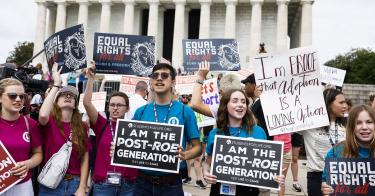One year ago, on June 24, 2022, the Supreme Court righted a grave wrong by overturning Roe v. Wade, the 1973 Supreme Court decision legalizing abortion throughout the United States. In its Dobbs v. Jackson Women’s Health Organization decision, the court said that Americans can protect unborn life at any stage through “their elected representatives … in the States or Congress.”
In the past year, the pro-life movement has achieved some key lifesaving wins. But the radical pro-abortion Left is still racking up some wins as well. As we mark the first year free from the dark shadow of Roe, let’s take stock of the victories, losses, and prospects to protect life in a post-Roe America.
Wins
After the Dobbs decision, many states moved quickly to protect unborn life through all nine months of pregnancy. Some states had their “conditional laws” spring to life. These are pro-life laws that states passed that were actually unconstitutional while Roe was still the law of the land but that would go into effect if the 1973 Supreme Court decision was ever overturned. Other states asked courts to let pro-life laws go into effect that had been blocked under the Roe regime. Still, others enacted strong pro-life protections once state legislative sessions convened.
Half the states now significantly protect life, including 14 with full nine-month protections from abortion and still more with “heartbeat” laws (laws that ban abortion once a heartbeat can be detected at about six weeks) or laws protecting children after the first trimester.
Some strong state laws are currently blocked while things play out in court as abortion proponents have sued to block them.
Compared to the legal landscape under Roe, these lifesaving laws now protect tens of thousands of women and unborn children each year from the violence of abortion.

While the state of U.S. abortion data collection isn’t 100% reliable, one study estimates roughly 30,000 fewer abortions have happened since Dobbs. Every single one represents a unique and irreplaceable person who now has a chance at life, and a woman who wasn’t harmed physically or emotionally by abortion.
Woes
When it comes to ballot initiatives to protect life or enshrine abortion in state constitutions, the pro-abortion side has had the edge. Voters in Kansas and Kentucky declined to protect life in their state constitutions post-Dobbs. California, Michigan, and Vermont voted to embed a right to abortion in their state constitutions.
States like Illinois, Massachusetts, and Vermont expanded access to dangerous chemical abortion pills. Other states like Minnesota and New Jersey enacted laws specifically protecting unfettered access to abortion through all nine months of pregnancy. New York and other states have enacted different kinds of so-called shield laws. These laws can, for example, stop law enforcement agencies in the pro-abortion state from cooperating with another state or licensing board’s investigation being conducted in a pro-life state.
Looking Forward
Fighting dangerous abortion pills must be among the highest of pro-life priorities in every single state. Bad actors in pro-abortion states flout the law and ship pills into pro-life states to mothers to use at home on their own, leaving women and their babies to suffer the consequences alone.
Abortion pills have a complication rate four times that of a first-trimester surgical abortion. Yet the Biden administration has recklessly removed longstanding safety standards so that these pills can be ordered by mail after superficial telemedicine consultations or obtained in retail pharmacies like Walgreens and CVS (turning our neighborhood pharmacies into abortion clinics).
Some women still travel from pro-life states to pro-abortion states to have an abortion. So, beyond just preventing abortions within their own borders, pro-life states must continue to foster a culture of life more broadly to discourage abortions. From tax credits to Medicaid expansion to funding for pregnancy care centers, there are additional policies legislators can craft to best meet the needs of moms and babies in their states.
But this is not just a state issue. The U.S. Congress, for its part, must embrace its role in protecting unborn life. The Heritage Foundation has provided the road map: Congress can and should prohibit taxpayer funding for abortions, protect human beings from lethal discrimination in the womb for reasons like sex selection or having Down syndrome, and protect unborn children with beating hearts. Federal policymakers have a duty—and a constitutional role to play—in protecting women and unborn children. (The Daily Signal is the multimedia news and commentary outlet of The Heritage Foundation.)
There is a slim pro-life majority in the U.S. House of Representatives. Earlier this year, it passed the Born-Alive Abortion Survivors Protection Act that requires medical care be provided to babies born during botched abortions (previously, abortionists could just let these children die on the abortion table or in the waste can).
However, that bill and future pro-life bills face a hostile Democrat-controlled Senate and president. But this political challenge should not deter federal policymakers from doing the right thing and taking a bold stance for life. Votes on pro-life bills—even those bills that may not pass both houses or be signed by the president—expose the radical Left’s agenda of abortion on demand through all nine months of pregnancy, paid for by the taxpayers.
The American people—who, polling shows, do not support abortion on demand, and certainly not through all nine months of pregnancy—deserve to know where each member stands.
The past year’s pro-life progress is cause for celebration. But overturning Roe was never the pro-life endgame. Only when every woman and unborn child is protected from abortion in all 50 states and U.S. territories will this great human rights fight of our time be over.
This piece originally appeared in The Daily Signal




